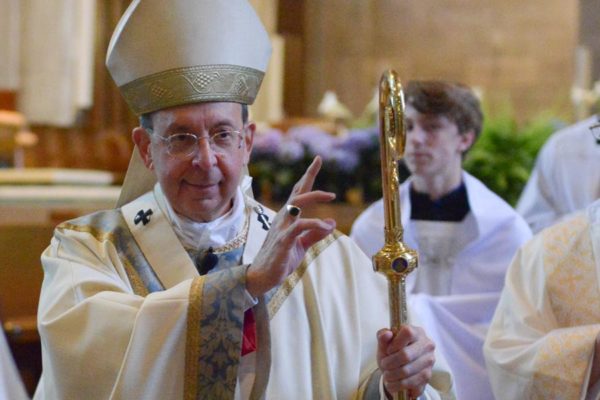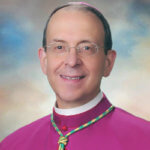St. Eusebius of Vercelli
Friday of the 17th Week of Ordinary Time
Knights of Columbus Board
Minneapolis, MN
August 2, 2019
Jewish Feasts
If you’ve ever wondered about the origins of the Church’s liturgical year, then you’re really in luck this afternoon! In today’s reading from the OT Book of Leviticus we find the origins of the liturgical seasons we, as Catholics, observe in the course of a year – Advent, Christmas, Lent, Easter, and in these days, Ordinary Time. How did all that develop? And what ought it to mean to us as practicing Catholics?
Biblical scholars tell us that today’s passage from Leviticus constitutes the most complete list of Jewish feasts in the Old Testament, feasts that were established as part of the Law of Moses. The lead feast is Passover, celebrating the deliverance of the Jewish people from the slavery of Egypt to the freedom of the Promised Land, a deliverance that came to epitomize our liberation from the slavery of sin to the freedom of holiness and the joy of eternal life. Other feasts took place at harvest time, while the Day of Atonement was set aside for mortification and repentance. Also included is the Feast of Booths in which the people of Israel commemorate the forty years they spent in the desert. Tomorrow’s reading from Leviticus will skip over the remaining Jewish feasts and instead focus on the Year of Jubilee that occurs every fifty years, the remote origins of the Holy Year which our Church observes every fifty years.
All of these Jewish feasts were tied to the changing of seasons, that is to say, the order of the cosmos, but in celebrating the orderliness of the universe, the people of Israel also inserted celebrations of the great and mighty deeds by which God in mercy delivered them throughout their history. In other words, these feasts were celebrations of both creation and redemption.
The Liturgical Year
As Mass-going Catholics we are aware of the seasons of the Church’s liturgical year. Like the Jewish feasts, the Church’s sacred year is tied to the winter solstice, the depths of winter, the darkest time of the year, indeed that time when Christ, the light of the world, was born. It is also anchored in the spring equinox when light begins to overtake the darkness. This is the time when we celebrate most solemnly the death and resurrection of Christ, the light from on high which the darkness of this world could not overcome.
The Church thus transforms the changing of the seasons of nature into a sacred time when we re-live the historic and living mysteries of Christ: the period of expectation before his birth, i.e., Advent; his coming into human history as Son of God and Son of Mary, i.e., Christmas; his death and exaltation and the sending of the Spirit, i.e., Lent, Easter and Pentecost; the period in which we delve more deeply into Christ’s teaching and miracles, that is to say, the liturgical season known as Ordinary Time. This is point of the Liturgical Year: By renewing and reliving the mysteries of Christ, the episodes in his life that reveal the hidden designs of the Triune God, we enter more deeply into intimacy with Christ, as individuals and as a community. It’s not that we haven’t celebrated Christmas or witnessed Holy Week time and again. But each year, when we return to the great events that brought us new life in Christ, the seasons of our lives should be more deeply sanctified and we should be more deeply embedded in the Christ-life than the year before. It is like a circular journey that takes us around and up the mountain, the mountain of the Lord, until we reach the pinnacle where Christ is seated at the right hand of the Father.
The Gospel of Matthew
If we faithfully renew and re-enact the mysteries of Christ, we will not make the same mistake as did the residents of Nazareth in the Gospel. They assumed that they knew Jesus, and his Mother, and his family – and so they thought they dismiss him as an eccentric, itinerant rabbi. Actually, it was worse than that. They were scandalized by him. They took offense at him.
I don’t think any of you are in danger of denying the divinity of Christ but, you know, our faith can be endangered by complacency and lack of attention, to such a degree that we fail to regard our Redeemer any longer with that gift of wonder and awe given to us by the Holy Spirit. Yes, it is all too easy to take Christ for granted, to presume that his mercy does not require us to repent, or to fail to see the supreme importance of all that he said and did to save us. By entering into the liturgical year thoughtfully and prayerfully, we are saved from presumption and complacency, twin dangers to holiness and eternal salvation.
The saint for today, St. Eusebius of Vercelli, is not exactly a household name but this 4th century saint certainly brings home the central message of our readings. Eusebius lived a life of intense personal and liturgical prayer focused on Christ and so, as a bishop with the heart of a monk, he had the wisdom, insight, and courage to defend the fullness of Christ’s divinity against the onslaught of the Arian heresy. St. Eusebius suffered imprisonment for his defense of the faith, and now from his place in heaven, he prays for us, lest we become presumptive or complacent in our journey of faith.
Conclusion
In these days when we prepare for our 137th Supreme Convention, thanks to the hospitality of the Minnesota State Council, we look forward to welcoming in large numbers the family of the Knights of Columbus and to being renewed in the principles of the Order – charity, unity, and fraternity. When we think about it, these principles, like the liturgical year itself, point to Christ and call us to live the life of Christ in a spirit of unity, courage, and joy.
May these days, and indeed all our days, be sanctified as we renew and re-live the saving mysteries of Christ, Christ who is our life and salvation, Christ who is our wisdom and joy. And may our dear Savior bless us and keep us always in his love. Vivat Jesus!


